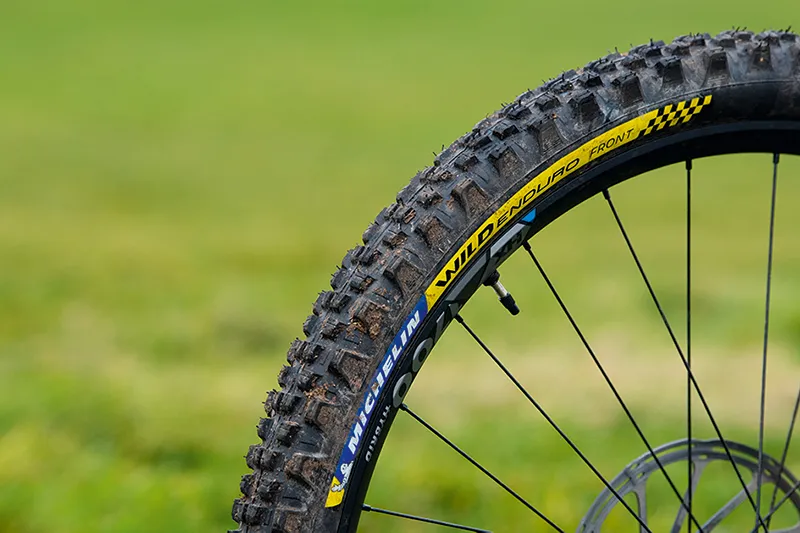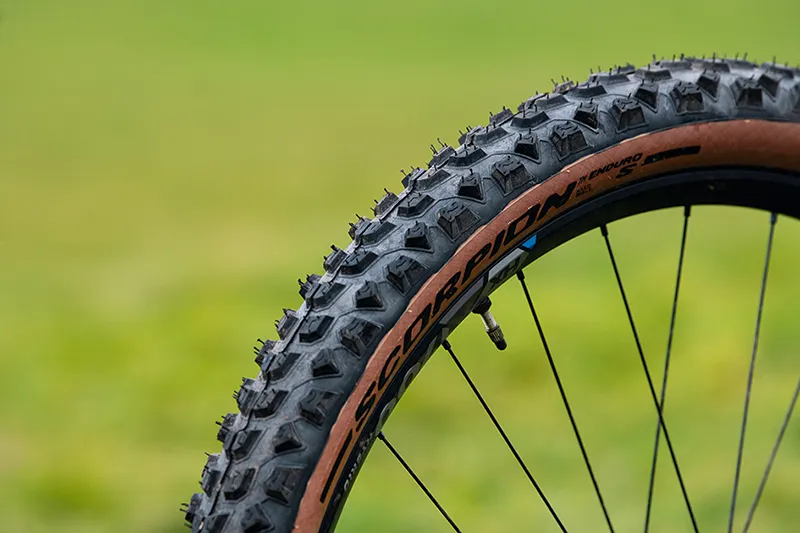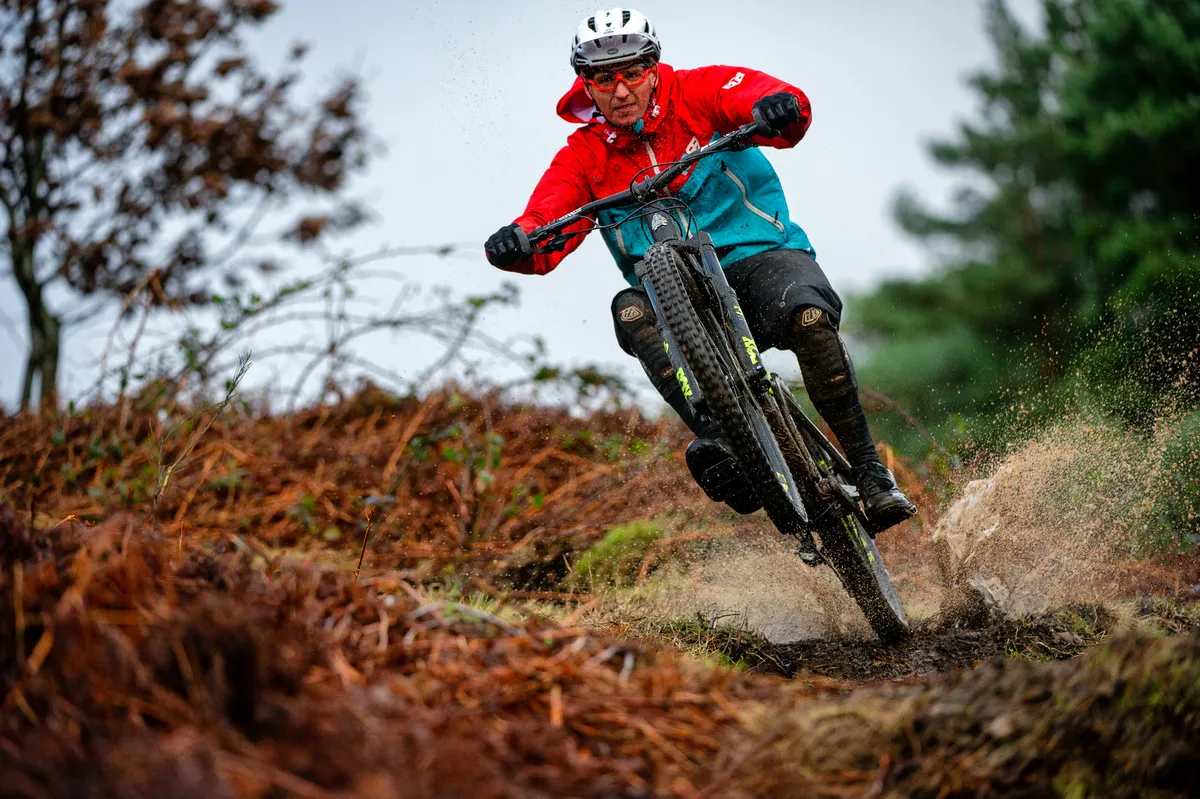The best winter mountain bike tyres can transform your riding when the weather turns sour and the trails turn muddy.
Switching from a faster-rolling summer tyre to a winter mountain bike tyre with tons of grip can make the difference between riding and sliding, railing or crashing, puncturing or ploughing.
We’ve tested a wide range of winter mountain bike tyres to see you through the slop, from aggro all-rounders to spiky mud munchers.
Here's our pick of the bunch, as rated and reviewed by the BikeRadar team.
Otherwise, you can head to our round-up of the best mountain bike tyres for our pick of trail, enduro and downhill rubber for year-round or summer riding.
Best winter mountain bike tyres
Schwalbe Magic Mary Super Trail ADDIX Ultra Soft

- Price: £67 (as tested)
- Weight: 1.23kg
- Size: 29x2.4in
- Measured width: 2.3in
The Schwalbe Magic Mary is still one of the best all-rounder winter tyres you can buy. It holds its line and damps bumps well for its weight.
Its grip is impressive in most conditions, through corners and on cambers. The Ultra Soft compound makes short work of slippery roots and rocks. Mud clearance is good, too. The confidence it delivers is impressive. Tubeless seating was easily dispatched with just a track pump.
We did, however, have to use a tyre lever to fit it. Its carcass isn't quite as stable as some of the other tyres we have tested. It is also fairly heavy for a trail tyre and made from soft rubber – it isn’t the easiest to pedal and rolls relatively slowly, though Schwalbe does offer firmer compounds.
Michelin Wild Enduro Racing Line Front

- Price: £65 (as tested)
- Weight: 1.42kg
- Size: 29x2.4in
- Measured width: 2.28in
We managed to seat and inflate the Michelin Wild Enduro Racing Line Front tyre with just a track pump.
Its downhill casing makes it extremely stable, giving plenty of control and confidence. The Magi-X DH compound is also impressively grippy on a variety of surfaces, and its aggressive side knobs give plenty of grip on cambers and in corners.
However, its tough casing meant we needed tyre levers to wrestle it on. It’s also heavy and slow-rolling, which makes it a chore for everyday riding. The centre treads are packed a little tighter than on other designs here, so they don’t clear thick mud that easily.
WTB Verdict TCS Light/High Grip

- Price: £60 (as tested)
- Weight: 1.16kg
- Size: 29x2.5in
- Measured width: 2.32in
The WTB Verdict is one of the most aggressively treaded winter tyres we've tested and performs excellently in heavy mud as a result, its well-spaced knobs biting into the dirt with ease.
WTB’s soft ‘High Grip’ rubber compound means it’s good on roots and rocks, too, and deforms well over obstacles on firmer trails to improve grip and comfort.
Unlike some tyres on test, we had to resort to using an inflator to seat these. The single-ply casing also isn’t as sturdy as some, though WTB does offer a heavier ‘Tough’ option if you want a more stable tyre.
While it doesn’t get knocked off-line easily, the lighter casing means bumps aren't as well damped as other tyres on test. Rolling speed is middling, too.
Also consider…
These tyres scored fewer than four out of five stars, but are still worth considering.
Continental Der Baron Projekt

- Price: £65 (as tested)
- Weight: 1kg
- Size: 29x2.4in
- Measured width: 2.34in
We were able to fit the Continental Der Baron Projekt with a track pump and without grabbing the tyre levers.
Its wide tread spacing clears mud well. If you want a winter tyre for ‘trail’ rather than off-piste/enduro use, the Der Baron Projekt is one of the lightest we've tested and one of the fastest-rolling, too, so it performs well on hardpack.
However, with one of the shallowest treads on test, it struggles to find traction in thicker mud and the shorter side knobs don’t bite into cambers or corners as aggressively.
The thin casing makes it less stable than others here, and the wide-spaced blocks give it a less predictable feel.
Vittoria Mota 2PLY

- Price: £60 (as tested)
- Weight: 1.24kg
- Size: 29x2.35in
- Measured width: 2.24in
We were able to fit the Vittoria Mota without tools, but still found the dual-ply casing to be incredibly tough for its weight.
This meant we could run lower pressures without suffering any flats. Its narrow width means you can ride with great accuracy, yet it still has good stability.
We had to use a tyre inflator to seat the bead on the rim, after struggling with just a track pump. The shallow tread is also quick to become overwhelmed in thicker mud and the Moto doesn’t have class-leading grip.
It’s better suited to wet trails with a firm surface underneath than claggy tracks.
Pirelli Scorpion Enduro S Classic

- Price: £70 (as tested)
- Weight: 1.1kg
- Size: 29x2.6in
- Measured width: 2.48in (at 21psi)
Installing the Pirelli Scorpion Enduro S Classic was easy without tyre levers, and the casing inflated with a track pump. It’s also light for an enduro-spec tyre.
The tread blocks are relatively deep and their large volume adds extra puncture protection, yet they still roll well.
Pirelli’s SmartGRIP compound is firm and doesn’t conform to the ground, slippery roots or rocks as well as other tyres we have tested.
The large tread blocks don’t bite into soft dirt either, making the tyre better suited to wet hardpack trails than mud. We found we weren’t able to commit to our lines as confidently with this tyre.
What to look for in a winter mountain bike tyre
Profile
The profile of a tyre is best thought of as a cross-section if you chopped out a slice of the tyre.
Squarer tyres bite harder into slippery turns and off-camber sections. Rounder tyres offer a more predictable drift – they generally roll faster and carry speed better through flat corners. Remember, wider rims make any given tyre squarer.
Casing
Often overlooked, the casing – or carcass – is the (usually) nylon-reinforced body of the tyre.
Designing a carcass is a balancing act between weight and rolling resistance on the one hand, and puncture-resistance, damping and stability on the other.
Carcass design has a huge effect on the rolling resistance and traction offered by a tyre.
You can read our full guide to tyre casings.

Compound
The compound of a tyre describes the rubber mix used in the tread.
Softer rubber sticks better to hard surfaces and offers more damping, but increases drag and wears faster. The softness is measured in durometer, with lower numbers (e.g. 40a) indicating softer rubber.
Damping
A well-damped tyre is one that uses a thick, rubbery casing and soft tread compounds that absorb the energy of bumps to resist bouncing off them.
This results in a calmer ride and more traction, but inevitably means more rolling resistance and weight.
Tread
Taller, spikier tread blocks offer more grip on soft ground, but generally increase rolling resistance.
For winter riding, look for widely spaced blocks to prevent mud-clogging, while siping (grooves) on the tread helps it stick to hard ground like a mountain goat’s hoof.
